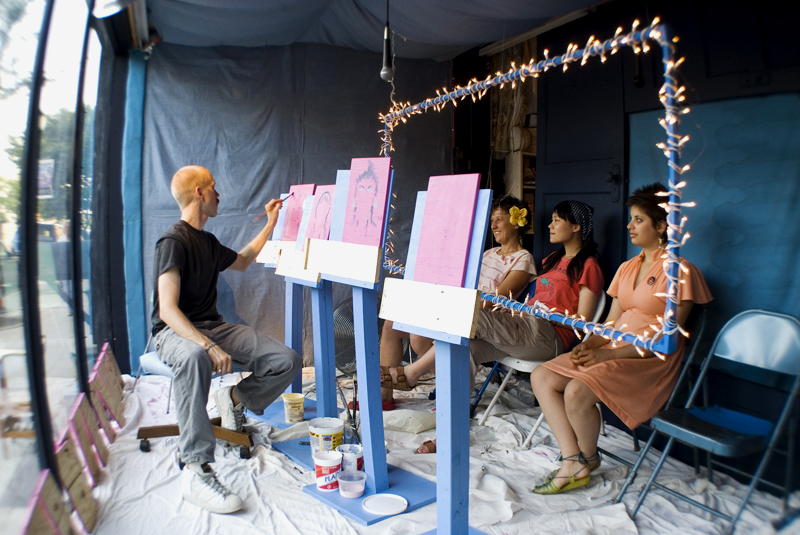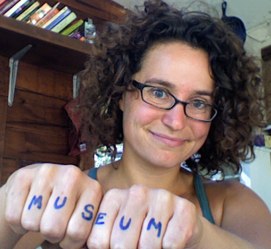Imagine a community-owned place that organizes and celebrates the objects, stories, and artwork that’s most important to you and your neighbors. Imagine a vibrant, social place where you can explore these objects with friends and strangers, learning more about yourself and each other through them.
Are you imagining a museum? For most of us, realistically, the answer is no. Even though the majority of museums, especially public ones, were built to steward and showcase the artifacts that represent the collective values of a community, they don’t necessarily feel that way to visitors. For a lot of people, visiting a museum feels more like visiting someone in the hospital than spending time with objects that we all collectively own. You can only come at certain hours. You can’t touch anything. You can’t eat. The rules are external, and they often prevent the kind of sharing that we associated with collective property and experiences.
But that’s changing. There’s a major shift going on in museums around opening up authority and ownership, propelled by the rise of the social web and visitors’ expectations of greater participation and involvement. Museums want to be relevant, dynamic cultural centers, and several are working on the big changes required to make that happen. From tiny art centers that invite people to vote on their favorite works, to national history museums inviting citizens to help determine which objects are most essential to their story, here are ten institutions doing innovative work to change the way we share and
perceive cultural experiences:
Every museum has warehouses full of artifacts in storage. In 1989, the director of the museums of Glasgow decided these objects could be more useful if they were made available without restriction to community members to use for their own exhibitions and research. Since then, the Glasgow Open Museum has loaned hundreds of objects to people in senior centers, prisons, schools, and businesses for their own use. By sharing their collection with the community, the Glasgow Open Museum has helped people of all kinds—including many people who don’t or can’t visit museums—feel ownership and connection to the institution.
What the Glasgow Open Museum does with physical objects, the Brooklyn Museum does online. 93,000 objects from the Brooklyn Museum’s collection are available online as high resolution image downloads with Creative Commons licensing and opportunities for visitors to tag and improve artifact documentation. They provide an API to their online collection and have cross-posted images with no known copyright to the Wikimedia Commons and Internet Archive for use across the web.
The Wing Luke Museum (picture by Nina)
The Wing may be small, but it is a leader in collaborative design and engagement. It’s a true community museum, built by, of, and for its neighborhood of Asian immigrants in the Seattle area. Every exhibit is designed not by curators, but by community members with diverse expertise on the topic at hand. The exhibits cover everything from refugee journeys to Asian-American soldiers’ experiences in Iraq and Afghanistan, all shared from first person perspectives. Even as an outsider to the community, walking into the Wing Luke feels like walking into the center of an ongoing discussion about how to understand history and make the future a better place.
Want to watch puppet shows on a shipwreck, or take part in a plant vacation? Machine Project is a non-profit storefront arts venue that hosts a dizzying array of eclectic classes, workshops, events, and occasional exhibits. It was started in 2003 and is run by Mark Allen and a collective of artists. Many of these collaborators have also been applying their talents by performing "interventions" at formal art institutions including LACMA, the Hammer Museum, and the Contemporary Art Museum in St. Louis. What makes Machine special is its brand of humor and accessibility, combined with a real dedication to experimenting on the borders of art, science, and ideas. They may not have a collection, but their programming opens up the way people perceive art experiences.
5. The National History Museum of the Netherlands (Amsterdam, NL)
This museum hasn’t broken ground yet, but they’re already doing exciting projects to invite citizens from around the country to get involved in determining what belongs on its walls when it opens. For example, their National Vending Machine allows people to trade stories about history for evocative artifacts that they can take home. Want to visit a museum that’s already supporting this kind of participation live with visitors? Then check out the
Oakland Museum of California, where the history gallery is awash in a dynamic spread of community-contributed comments, stories, and objects.
Want some waffles with your art? The Waffle Shop is a cafe and live-streaming TV channel that serves a diverse audience of late night club-goers and locals in urban Pittsburgh. It's run by Jon Rubin, an artist and professor of social practice at Carnegie Mellon, and his students. It's a fascinating experiment in connecting with "nontraditional" arts audiences and encouraging strangers to talk about diverse topics in a performative environment. Both staff and visitors host TV programs in the spaces that range from interviews to game shows to salon chair ministries. The Waffle Shop team also runs other projects out of the space, including the Conflict Kitchen–a take-out place that serves food from countries that the U.S. is in conflict with (currently, Iran).
This now-defunct popup museum sourced all of its exhibition material from regular citizens of Denver, who created artworks in response to open-ended challenges posed by the institution. The director, Jaime Kopke, found ways to turn every visitor into a participant, and the result was an eclectic, diverse community of stories and objects. While it was implemented as a short-term project, the DCM has influenced other similar projects, like
the San Francisco Mobile Museum, which tours shoebox-sized, user-generated exhibits around the city.
If you're looking for inspiration with a collections focus, the Underground Library is a compelling experimental space dedicated to archiving all media produced in Chicago. They have an open collections policy, and they see media artifacts as objects that connect people to art, to history, to politics, and to each other. The library is run in the lobby of a theater company by a group of volunteers led by Nell Taylor. Nell and the Underground Librarians are passionate about helping people see the relationships between media artifacts and lived experience in the city, and they spend a lot of their time soliciting artworks and publications from unlikely corners to flesh out their collection and honor the diversity of content production around Chicago. Whether a teen zine about punk music or a university journal, the Underground Library will collect it, catalog it, and share it in ways designed to help people learn more about their city and each other.

The Elsewhere Collaborative at work (photo by the Collaborative)
Elsewhere is another collection-based project, but in this case, the collection is the basis for artwork rather than the other way around. In 2003, writer George Scheer inherited his grandmother's thrift store and decided to turn it into an artists' center and museum. The Collaborative engages artists-in-residence who reinterpret elements of the thrift store into new works, which they then share with the public. Their projects are an inspiration for anyone interested in looking at new ways to reinterpret a collection (especially a weird and overflowing one) and in doing so, bring together a community of artists and locals.
If you are looking for experiments in taking a formal, traditional art venue and reconceiving it as a community space that attracts a diverse audience, look no further than Streb Labs. In 2003, the successful choreographer Elizabeth Streb moved into a huge warehouse space in Brooklyn on a busy street and threw the doors open to locals, 24/7. As Streb explains, "SLAM is an open-access venue that models a new kind of artist-driven community institution. The doors of SLAM are never closed. Performances at SLAM are not stiff, class-coded, regimented affairs; they are neighborhood happenings where the company's longtime fans from the high-art crowd mingle with the "at-risk" kids from the local public schools and their parents. At the heart of this machine is the driving force of art and action, and the belief that art can provide a service to a community such that voters, taxpayers, and consumers will consider it indispensable." Check out their site and if you're inspired, listen to this fabulous 20 minute interview with Elizabeth on The Artful Manager blog.











